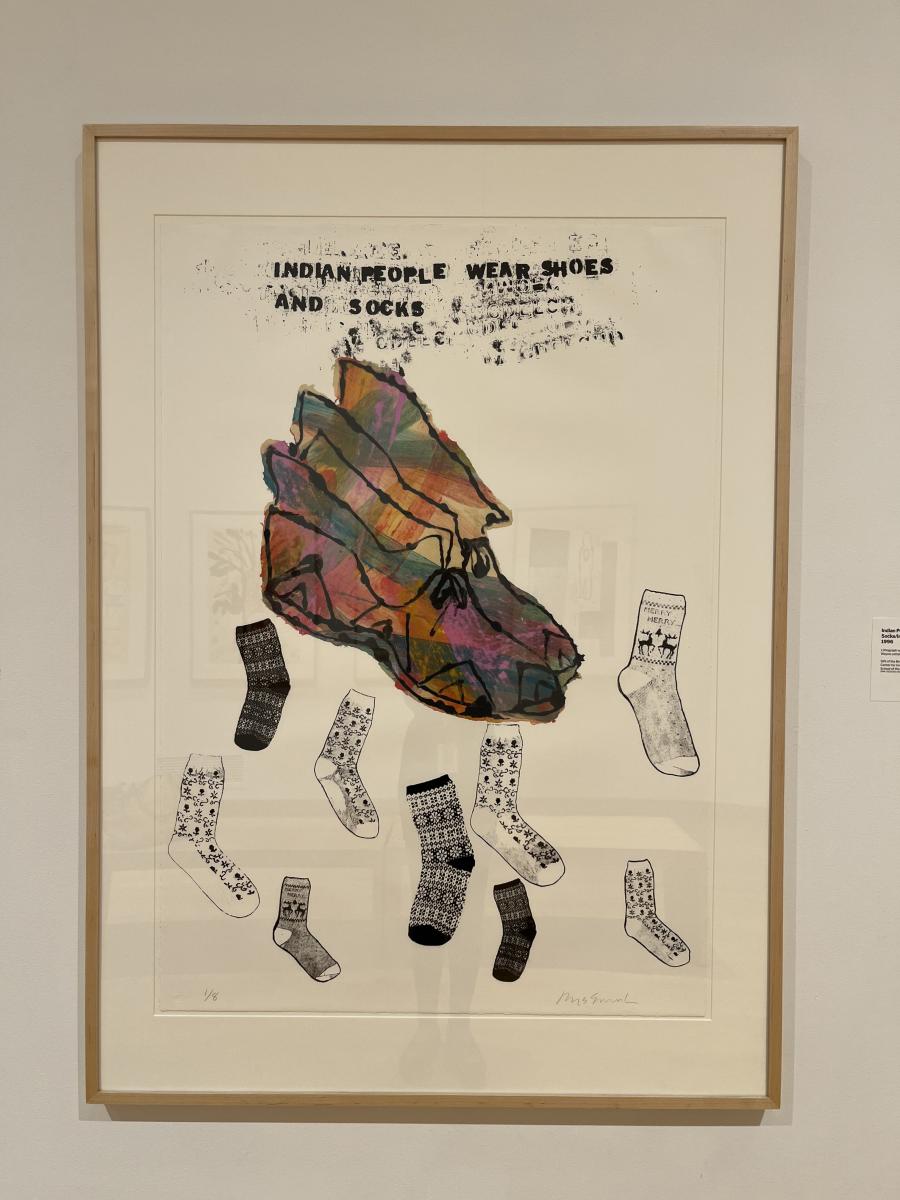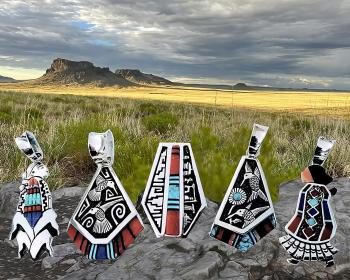Darnella Davis is an artist, educator, policy analyst, and member of the Muscogee Creek nation, with tribal roots in Oklahoma and Michigan. Davis exhibits her figurative watercolors, drawings, and oil paintings nationally and abroad. In 1992 and 1993, her work was seen throughout the United States in the College of Wooster Art Museum’s two-year traveling exhibition “We the Human Beings: Twenty-Seven Contemporary Native American Artists.”
Davis explains, “Imagery in my work arises in part form my mixed heritage and in part from—and in reaction to—my Eurocentric training. Across time, my genealogical research has unearthed words and pictures of my ancestors that reaffirm my place as the descendant of a long line of mixed-race peoples who struggled to keep their ways and their land. Although this personal information may provide some context for interpreting my paintings, the inspiration for this work springs from a source beyond personal history, where the color yellow signals a shift from the ordinary. In this visionary world, one can discern an America perceived not through the logic of the mind, but sensed by the spirit and the heart, a place accessible, perhaps, to our children’s children.”
The watercolor Grace and Hope was exhibited in the two-person show Native Color that we both participated in at the Parish Gallery in Washington, D.C. In this painting, two nude figures, one with lighter skin than the other, walk in a simple neutral-colored landscape with a deep yellow sky. The time period and the figures’ race(s) are indeterminate. Are they an inter-racial couple, or people from the same tribe/ethnicity with varying skin tones? Is the nudity imposed or a symbol of their bodies in their natural state? Is this scene in America or a universal, primordial location? It is up to the viewer to determine the specifics of this open-ended narrative.
Recently I asked Davis to elaborate on this and two other paintings. Here is part of that conversation:
Darnella Davis:
At first glance, the time, location, and people’s race/ethnicity in Grace and Hope appear indeterminate, but a closer inspection reveals that this piece, as with others in the series, references the division of land seen during the Allotment Period. As the figures stroll along, their relationship is a generational one that conveys both history and possibility. Their potential interface with the land is colored by the allotment policies of the Dawes Act of 1887, which governed the division of tribal land to encourage individual rather than collective farming. Claims for the land and the size of any given allotment depended on racial purity or the strength of tribal affiliations. For a time, racial identity was a fluid notion in the individual scramble for land. The painting’s title suggests the possibility of retaining both dignity and optimism during a major cultural shift that for many had a corrupting influence on Indian Territory.
Phoebe Farris:
In discussing Yellow Haired Brown Girl you mention that “the color yellow signals a shift from the ordinary.” In your portrait, does the girl’s yellow/blond hair signify that blond/yellow hair is out of the ordinary for Native Americans, African Americans, or people of color in general? Or is the yellow background signifying an out of the ordinary physical environment for the girl?
Color is highly emotive in my work, and yellow skies appear with some frequency. I’m intrigued with the tensions surrounding unusual phenomena, especially events or actions that push us beyond the comfort of our day-to-day notions of boundary. In Yellow Haired Brown Girl, the light is warm and intense, almost oppressive. Perhaps it serves as a warning. It signals a departure from the ordinary range of gray to blue that we associate with our atmosphere (as when skies appear green just before a tornado or under conditions such as sand storms). Likewise, many mixed-race people display a range of physical characteristics, some of which more closely fit our expectations than others. Australian aborigines can be quite dark skinned with pale blond hair. Such individuals are less often seen here in the Americas but do exist as examples of a complicated mix of often-recessive genes. These extraordinary individuals recall to us the long-term intermingling of racial groups. The opportunity is to examine the edges of our comfort with who and what we have been and are, acknowledging a broader range of variance than is generally recognized.
The figure in Above the Ground is jumping high in contrast to most of your subjects, who are grounded. Can you explain your choice in depicting a more active pose?
This series of paintings queried the interactions of people to the land. Are we tied to the land? Can we own or possess it? Are we comfortable on it? As with chance, we might wonder, where will we land? Perhaps a leap suggests our tension with being placed or tied down. To some degree, we alternate between being grounded and up in the air. Above the Ground captures a momentary release from gravity.
Most of your figures are painted nude. Contemporary Native American artists only recently began using nudity in their art, although prior to European colonialism most of us wore minimal clothing. In many tribes women were bare breasted and men wore breechcloths. Why do you think Native American artists avoided the nude figure? Why do you feel more comfortable portraying nude figures?
Nudes are both primal and devoid of the time constraints imposed by contemporary dress. The issues that concern me may be grounded in the Allotment Period, but they have occupied groups and individuals throughout the ages. Unclothed people reside outside of time, or perhaps in a limbo of timelessness. In contrast, dress is often a form of celebration, signaling a confidence in, or an assertion of, the here and now.
What are your current research and art projects? Are you still publishing and lecturing about Creek Freedmen? Have you had any exhibits or publications since the recent analysis of your work in the 2009 “indiVisible” exhibition/book?
Based on 20 years of study, I have recently completed a book-length manuscript. I believe my research answers the call posed by the indiVisible symposium, documenting the stories of mixed race peoples. It is currently under review by a number of scholars in preparation for submission to a publisher.
--
In counteracting stereotypes and preconceived notions about racial and ethnic identities, Darnella Davis promotes understanding about the complexities of lives such as her family’s and in the process confirms that there is no monolithic Native American or African American experience.
As prominent scholar Jack Forbes (Powhatan-Renape) notes, unraveling existing misconceptions is almost as important as new conceptions. Forbes writes, “The ancestry of modern-day Americans is often quite complex…Persons have been forced by racism into arbitrary categories which tend to render their ethnic heritage simple rather than complex.”
Phoebe Farris is the arts editor for Cultural Survival Quarterly and teaches at Purdue University. She wrote about Darnella Davis in the book indiVisible:African Native American Lives in the Americas, parts of which are reproduced here by permission of the Smithsonian’s National Museum of the American Indian.



